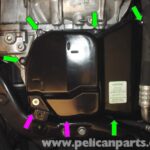On-board diagnostics (OBD2) ports are standard in most cars manufactured after 1996. While primarily used for diagnostics, many wonder about the possibility of programming their car using this port. This guide delves into OBD2 programming, exploring its capabilities and limitations.
Understanding OBD2 and its Programming Potential
OBD2 allows mechanics and car owners to access a vehicle’s diagnostic trouble codes (DTCs), providing insights into potential issues. However, its programming capabilities are more nuanced. While you can’t entirely reprogram your car’s core functions through OBD2, you can make certain adjustments and modifications.
What Can You Program with OBD2?
- Key Fobs: Some vehicles allow programming new key fobs via the OBD2 port, eliminating the need for a dealership visit. This often involves specific procedures and may require specialized equipment.
- TPMS Sensors: You can often program new Tire Pressure Monitoring System (TPMS) sensors after tire replacement using an OBD2 tool. This ensures the system accurately monitors tire pressure.
- Injector Coding: In some diesel and gasoline direct injection vehicles, you might be able to code new fuel injectors to the engine control unit (ECU) using specialized software and an OBD2 interface.
- Certain Module Settings: Depending on the make and model, you may be able to adjust settings for specific modules, like lighting, door locks, or comfort features. This usually requires manufacturer-specific software.
What Can’t You Program with OBD2?
- Engine Performance Tuning: While you can access performance data, you generally cannot reprogram the ECU for significant performance gains via OBD2. This often requires specialized tuning equipment and software that directly interfaces with the ECU.
- Transmission Control: Reprogramming the transmission control module (TCM) for shift behavior changes is typically not possible through OBD2.
- Security Systems: Core security features, like immobilizers and alarm systems, are usually protected against unauthorized programming through OBD2.
OBD2 Programming Tools and Software
To program your car over OBD2, you’ll need specific tools and software.
- OBD2 Scanner/Code Reader: Basic scanners display DTCs, while more advanced ones provide access to live data and some programming functions.
- Vehicle-Specific Software: Often required for advanced programming, this software is typically provided by the vehicle manufacturer or third-party developers.
- OBD2 Interface/Adapter: Connects your computer to the OBD2 port, allowing communication with the vehicle’s systems. Examples include J2554 and CAN interfaces.
Considerations for OBD2 Programming
- Vehicle Compatibility: Not all vehicles support the same level of OBD2 programming. Consult your owner’s manual or a qualified technician to determine your car’s capabilities.
- Software and Hardware Requirements: Ensure compatibility between the software, interface, and your vehicle. Using incorrect tools can potentially damage your car’s systems.
- Technical Expertise: OBD2 programming can be complex. If you’re unsure, consult a professional mechanic to avoid potential issues.
Conclusion
While OBD2 provides limited programming capabilities compared to dedicated ECU programming methods, it still offers valuable functionality for certain tasks. Understanding these limitations and using the correct tools and software are crucial for successful and safe OBD2 programming. Always consult your owner’s manual or a qualified professional if you have any doubts.
